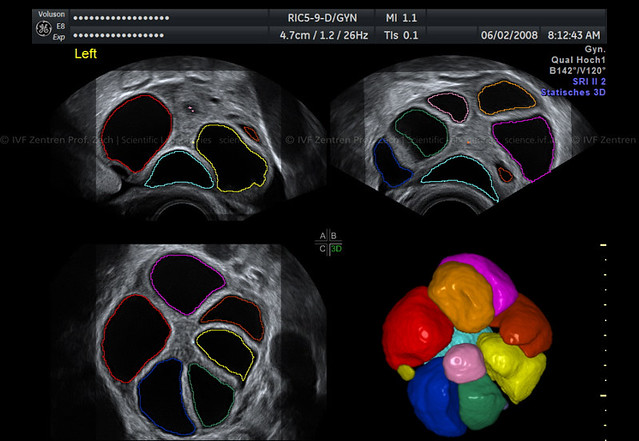Eggs obtained during follicular puncture following 3D ultrasound monitoring feature a higher fertilization rate. This is evidenced by a direct comparison between conventional 2D ultrasound and the new and more precise 3D ultrasound technology.
Areas of application
Compared to conventional ultrasound techniques, 3D ultrasound monitoring allows for a more precise evaluation of volume and size of the maturing follicles and hence for a more exact prediction of their degree of maturity.
Ultrasound has long since become a standard feature in reproductive medicine. It is used, for example, in the preliminary examination of the female reproductive organs. This allows for example to detect possible pathological changes or disorders of the uterus resp. the ovaries (e.g. uterine polyps or other growths, myomas or cysts).
Ultrasound scanning plays a fundamental role in ovarian reserve assessment, i.e. determining the amount of follicles that can actually be stimulated. The IVF treatment, too, is monitored by ultrasonography (ultrasound scan).
At the IVF Centers Prof. Zech we have been using three-dimensional ultrasound imaging as standard since 2009. This enables us to provide, in addition to a faster and thus more patient friendly procedure, objective assessment of the results and to guarantee high medical standards.
Ultrasound in the course of IVF treatment
IVF treatment initially involves the stimulation of a woman’s ovaries by means of the appropriate medication in order to allow more follicles to reach maturity and produce a sufficient number of eggs. During the stimulation phase, growth and size of the follicles containing the maturing oocytes are currently monitored by the treating doctor using ultrasound.
This constant monitoring has two major advantages:
- The optimum moment for administering human chorionic gonadotropin (hCG) to induce ovulation can be determined.
- This allows for selecting the most suitable moment for follicular puncture in order to retrieve the mature eggs from the ovaries.
In practice, however, this proves to be relatively difficult, since each patient reacts differently (sometimes from one cycle to the next) to ovarian stimulation. Ovarian follicle size, however, clearly correlates with the maturity degree of the egg, thus providing a reliable indicator for determining the ideal moment for the hCG injection.
So far, only two-dimensional conventional ultrasound techniques were available to determine follicle size and volume. This is why the actual follicular volume and the timing of the trigger shot could only be vaguely estimated.
Clinically tested
The IVF Centers Prof. Zech entered into cooperation with GE Healthcare, the global market leader in the field of diagnostic ultrasound systems, which, for the first time, made it possible to clinically test the application of an entirely new 3D ultrasonic procedure for the precise and automated measuring of follicles during ovarian stimulation. In direct comparison with conventional 2D ultrasound technology, it was found that a higher fertilization rate could be achieved using the eggs harvested after 3D ultrasound monitoring.
Cooperation and coordination
Conception, planning and realization of IVF treatments, on the one hand, are performed by specialist centers and are based on high specialization, technical standards and are coherent with legal provisions. Medical care for patients and ultrasound monitoring, on the other hand, are mainly provided by local gynecologists. It is usually the established gynecologists that examine and diagnose the patients and, when indicated, refer them to a specialized fertility center and subsequently support and accompany them during therapy.
During this “support” process, the previously described ultrasound scans constitute an integral part of patient monitoring in order to adapt the stimulation plan and ensure an optimal therapeutic process. To this end, the processing, “readout” and evaluation as well as the correct and timely transfer of ultrasound findings are crucial.
This gives rise to two basic problems: First, the required prompt data transfer from the gynecologist to the IVF center often represents a logistic problem. Secondly, the subjective interpretation of an ultrasound scan increases the proneness to error leading to considerable disadvantages for patients and their treatment.
Clear plea for 3D ultrasound technology
We, at the IVF Centers Prof. Zech argue in favor of a broad use of the 3D ultrasound technology described above. In this way, the above mentioned error sources can be avoided. The 3D ultrasound technology allows a fast and loss-free data transmission (transmission of the results) between local doctors’ surgeries and the IVF Center via PACS Server.
Using medical software – such as DynaMed ® , the results may be automatically incorporated in the patient records.
Click on this YouTube video and learn more about this cutting-edge innovation.
→ read also »Starting Fertility Treatment-Part 3 – Ultrasound Scan«
← Home
→ Contact
















